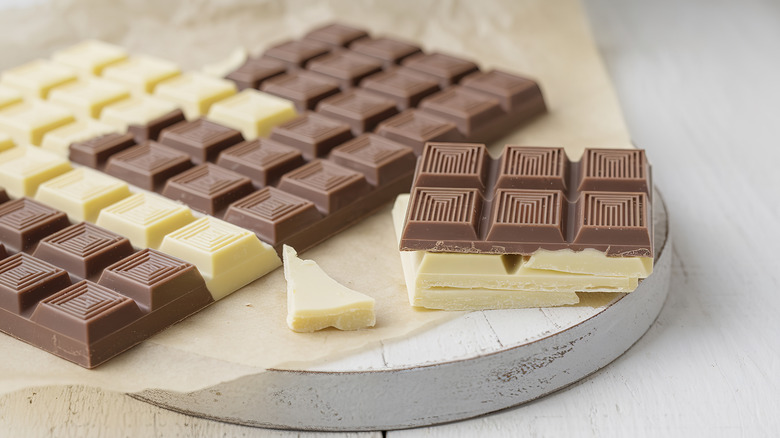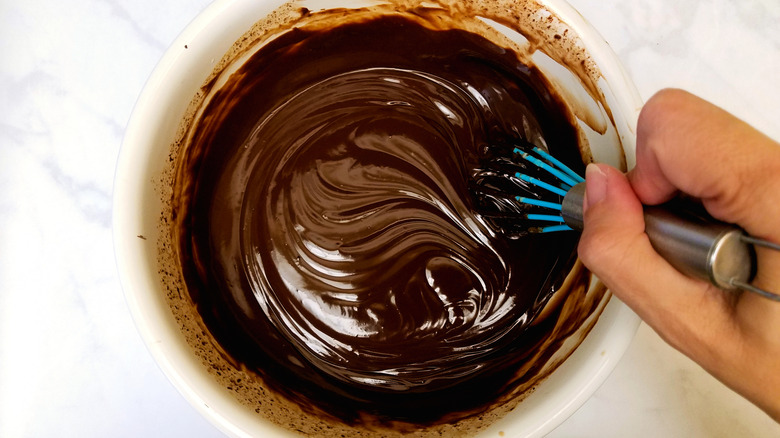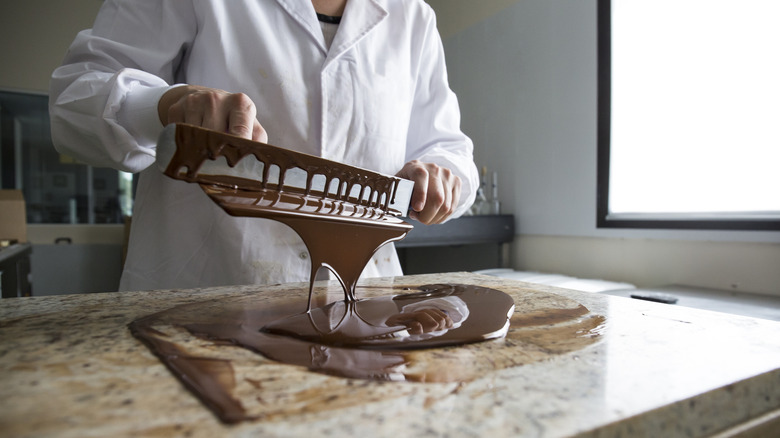What Really Sets White And Milk Chocolate Apart
Ah, chocolate. It's one of, if not the most beloved of confections, whether in a candy bar, an ice cream, whipped into a delightfully fluffy mousse, or even drank (with a pinch of salt for an extra boost of flavor, of course.) It's common knowledge that chocolate usually comes in three variations: dark, milk and white. Each has their own unique flavor profile, makeup, and methods of production. White chocolate enjoys a certain degree of distinction, with some claiming that it isn't even chocolate at all. But while we might, visually at least, be able to tell the difference between them, most of us probably don't know what actually sets white and milk chocolate apart.
The ingredients are perhaps the most significant difference. Milk chocolate contains the familiar combination of cocoa (known to chocolatiers as "cocoa solids"), cocoa butter, sugar, and milk (typically either powdered or creamy and condensed). This interplay of bitter from the cocoa, sweet from the sugar, and milkiness from the dairy results in a well balanced flavor profile, not as overtly "chocolatey" as, say, dark chocolate, but still with enough of that signature earthy sweetness to satisfy.
White chocolate, meanwhile, contains no cocoa solids at all. Rather, it's made entirely from cocoa butter, sugar, and milk. As a result, it lacks that characteristic earthiness that we associate with chocolate, instead providing a particularly sweet and creamy bite, often with notes of nuttiness from the milk, or even a hint of vanilla.
White and milk chocolate differ in their melting points and uses
Their composition isn't the only difference between white and milk chocolate. They also differ in the way in which they're most commonly used. Of course, both can be eaten on their own, just as they are — and they are both undeniably delicious. They're also often a common flavoring for custards, drinks, and ice creams. But it's in their other uses that you'll find the most variety.
White chocolate has a slightly lower melting point than milk chocolate, making it a little less stable — and as such more prone to overheating or burning. This makes it a little more difficult to work with and can limit the number of applications it has for the at-home cook. Typically, it's used for decoration when baking, whether shaved over cakes, mixed into a delicious ganache, or used when making filled chocolate bars or truffles. It's also particularly delicious when incorporated into custards, such as a crème pâtissière for filling éclairs or donuts, or an indulgent crème brûlée.
Milk chocolate, meanwhile, is a little more forgiving to work with as its higher concentration of cocoa solids means it has a slightly higher tolerance to heat. This higher melting point makes it more versatile than its white counterpart, and it has innumerable uses in baking, confectionary, and even in savory recipes, especially Mexican dishes involving chipotle and ancho chiles, which have a similar earthiness and nuttiness that are already "chocolatey."
White and milk chocolate also differ in their production processes
If you're not familiar with the process of turning roasted cocoa nibs into milk chocolate, let us clue you in. It's a four stage process. Mixing is the first step, where the cocoa butter and solids are combined with sugar, milk solids (the milk powder or condensed milk we mentioned earlier), and any flavorings you might want to add, turning everything into one homogenous mixture.
The mixture is then refined, giving it a smoother texture. It's then ready for a process known as conching, where it's heated and mixed in a machine that essentially grinds it to an incredibly fine texture, distributing the cocoa butter evenly throughout the mixture to ensure a smooth, silky feel. The mixture is then tempered, which gives the final product its characteristic snap and shiny finish.
The process for making white chocolate is almost identical, save for two crucial differences. During the mixing process, the cocoa solids are omitted entirely, and there may be additional flavorings added to the mixture, such as vanilla (a flavor that pairs extremely well with white chocolate). The refining process remains the same, but the conching crucially happens at a significantly lower temperature than milk chocolate — below 140 degrees Fahrenheit. Any higher, and the chocolate risks burning. These low temperatures help develop white chocolate's signature mild, slightly malty flavor. Milk chocolate, meanwhile, is conched at higher temperatures — up to (and sometimes exceeding) 170 degrees, allowing the chocolate to caramelize, enhancing its "chocolatey" flavor.



